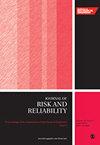致命冲击下k-out- n系统的预防性维护
IF 1.8
4区 工程技术
Q3 ENGINEERING, INDUSTRIAL
Proceedings of the Institution of Mechanical Engineers Part O-Journal of Risk and Reliability
Pub Date : 2023-01-12
DOI:10.1177/1748006x221147331
引用次数: 0
摘要
在本文中,我们研究了一个(n- k + 1)- of- n系统的最佳基于年龄的预防性维护(PM)策略,该系统的组件暴露于来自各种来源的致命冲击。我们考虑两种不同的系统故障场景。在第一个模型中,假设冲击过程属于马歇尔-奥尔金模式,即每次冲击影响系统的一个组件并使其失效,一次冲击影响所有组件并摧毁它们。在第二种情况下,假设系统受到扩展类型的Marshall-Olkin冲击过程的影响,其中随机时间到达的冲击可能导致1、2、…或n个组件的击穿。在组件失效的每种情况下,我们通过施加相关的成本函数来研究系统的最优基于年龄的PM模型。然后,在每种情况下,我们探索使每单位时间的平均成本最小化的最佳PM时间。给出了一些数值结果来说明所提模型的应用。本文章由计算机程序翻译,如有差异,请以英文原文为准。
On preventive maintenance of k-out-of-n systems subject to fatal shocks
In this paper, we investigate optimal age-based preventive maintenance (PM) policies for an ( n- k + 1)-out-of- n system whose components are exposed to fatal shocks that arrive from various sources. We consider two different scenarios for the system failure. In the first one, it is assumed that the shock process is of the type of Marshall-Olkin where each shock affects one component of the system and puts it down, and one shock affects all components and destroys all of them. In the second scenario, it is assumed that the system is subject to an extended type of Marshall-Olkin shock process where the shocks arriving at random times may cause the breakdown of 1, 2, …, or n components. Under each scenario for the components failure, we investigate an optimal age-based PM model for the system by imposing the related cost function. Then, in each case, we explore the optimal PM time that minimizes the mean cost per unit of time. Some numerical results are presented to illustrate the applications of the proposed models.
求助全文
通过发布文献求助,成功后即可免费获取论文全文。
去求助
来源期刊

Proceedings of the Institution of Mechanical Engineers Part O-Journal of Risk and Reliability
ENGINEERING, MULTIDISCIPLINARY-ENGINEERING, INDUSTRIAL
CiteScore
4.50
自引率
19.00%
发文量
81
审稿时长
6-12 weeks
期刊介绍:
The Journal of Risk and Reliability is for researchers and practitioners who are involved in the field of risk analysis and reliability engineering. The remit of the Journal covers concepts, theories, principles, approaches, methods and models for the proper understanding, assessment, characterisation and management of the risk and reliability of engineering systems. The journal welcomes papers which are based on mathematical and probabilistic analysis, simulation and/or optimisation, as well as works highlighting conceptual and managerial issues. Papers that provide perspectives on current practices and methods, and how to improve these, are also welcome
 求助内容:
求助内容: 应助结果提醒方式:
应助结果提醒方式:


